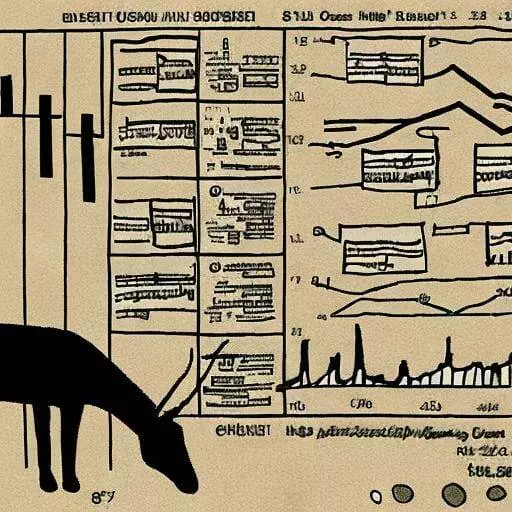Immerse yourself in the exhilarating, and at times complex, realm of stock investment! As an investor, you have the chance to make profits by trading securities in the stock market.
However, it’s important to understand that the stock market can be volatile and that there are risks involved with investing.
One way to assess whether a company is worth investing in is by analyzing its financial ratios. These ratios, such as the price-to-earnings ratio and the dividend yield, can give you an idea of a company’s valuation and earnings growth potential. Additionally, it’s important to look at the company’s earnings per share, which reflects the profit generated for each share of stock.
Another factor to consider is the company’s dividend yield, which is the annual dividend payment per share of stock divided by the stock’s price. A higher dividend yield can indicate a potentially lucrative investment, but it’s important to also consider the company’s overall financial health and growth potential.
Valuation is another key aspect to consider when deciding whether to invest in a particular stock. This refers to the perceived worth of a company’s assets and future earnings potential. There are several methods for valuating a stock, including the discounted cash flow method and the price-to-earnings ratio.
Ultimately, the value of a stock is determined by a combination of these and other factors. By understanding the key concepts of financial ratios, earnings per share, dividend yield, and valuation, you can make informed decisions about which stocks to invest in and potentially maximize your returns.
Top Things To Look For In A Potential Investment

When considering whether to invest in a particular stock, it is important to take a close look at the company’s financial health and reputation. One way to do this is to look at the market price of the stock, which reflects the current demand for the stock and can give you an idea of the company’s overall value. It is also important to consider the number of shares that are available and whether the stock is actively traded, as this can impact your ability to buy and sell the stock.
Another factor to consider when investing in stocks is the company’s financial statements, which provide information about the company’s revenues, expenses, profits, and debts. By analyzing these statements, you can get a better understanding of the company’s financial performance and potential for growth.
Ultimately, investing in stocks requires careful research and analysis. By considering factors such as the market price, number of shares, and financial statements, you can make informed decisions about whether a particular stock is worth investing in. It is always important to remember that investing in the stock market carries risks, and it is important to diversify your portfolio and manage your risk appropriately.
Finding Value In A Company
Finding value in a company is easier than you think. All you have to do is look at the following:
- The stock price relative to its intrinsic value (or growth rate). If a company’s stock is trading for less than it’s worth, then that can mean that there’s still room for upside.
- The return on invested capital (ROIC). ROIC measures how much profit each dollar of capital generates for an entity; if an organization has high ROIC, then that means they’re earning more money with their existing assets than they are spending on new ones—and this can help explain why they keep growing profits year after year without needing any additional funding from outside investors or financial institutions like banks or hedge funds.

The Importance Of Diversification
Diversification is the process of spreading your investment portfolio across various investments. This helps to minimize risk and increase your chances of earning a return on your money.
Diversification can be effective in several ways:
- It helps to ensure that you are not exposing yourself too much financially, which could lead to loss of capital or insufficient returns over time.
- It ensures that if one stock loses its value, it won’t impact your entire portfolio as there will be other stocks available for purchase (and this is especially true if you’re investing in companies with different industries).
- By opening up multiple streams of income within one company, diversifying allows investors more flexibility when it comes time for retirement planning because they won’t be tied down by any single company’s performance or financial health issues affecting their portfolio value negatively – thus allowing them better control over their future plans while still providing enough funding behind them so they aren’t left struggling after retirement age starts approaching fast!
Investing In Companies You Know And Trust
If you’re going to invest in a company, it’s important that you know and trust the management team. You should also do your due diligence on their past performance, as well as any other information available online about their business plan and goals.
When trading stocks, there are certain rules of thumb that will help ensure that you’re making an informed decision—and avoiding scams or frauds along the way. One way investors can avoid these pitfalls is by doing their own research before buying shares in companies they’ve never heard of before (or investing at all).
The Best Time To Buy Is When No One Else Is Looking
- The best time to buy is when no one else is looking.
- When the market is down, you can find stocks that are undervalued and buy them at a discount.
- You can also buy at a premium if the market is up in price, allowing you to purchase stocks at higher prices than they’re currently trading at—this way, your odds of making money on any purchases remain high!
Let The Trends Guide Us To Success
The first step to successful stock evaluation is recognizing a trend. Trending is important because it can help you spot an opportunity before the price rises too high and then falls back down again. But trends don’t last forever; they’re often only temporary in nature and may even disappear altogether if left unchecked by new developments.
In order to identify these trends, you have to be able to spot them while they’re still in their infancy stage—before they become popular or consolidate into something bigger than themselves—and then follow them through until they’ve run their course (or until there’s no longer any information available about them).
It’s Not About Being Right Or Wrong; It’s About Making Money
When it comes to investing in stocks, it’s important to consider a variety of factors that can impact the price of a stock, such as the value of the company, the outstanding shares, and the market value. One technique that can be helpful in this process is using a peg, which is a method of comparing a stock’s price to its earnings per share. By considering these and other factors, you can make more informed decisions about which stocks to buy and sell, and potentially increase your chances of making money.
Of course, it’s always important to do your own research and due diligence before making any investment decisions, as there are no guarantees in the stock market. Ultimately, understanding the price of a stock, how to stack with a peg, and the value of a company can all help you make more informed decisions about your investments.
Finding The Perfect Stock To Buy Is A Matter Of Doing Your Research And Waiting For The Perfect Moment.
Stock market investing may be complicated, but if you do some research and keep your cool, you will be able to find the stocks that are worth your hard-earned money.
Investing in stocks can be a challenging but potentially lucrative endeavor. To make informed decisions about which stocks to buy and sell, it’s essential to do thorough research on the companies you’re considering. This includes looking at their financial statements and getting insights from people who work at the company.
One factor to consider when evaluating a stock is its current value, which reflects the sentiment of investors and how much they’re willing to pay for the particular stock. This value, also known as the market price, is influenced by various factors such as the company’s performance, macroeconomic conditions, and overall investor sentiment. It can also be a reliable indicator of future growth, as it reflects the value placed on a company by current market investors.
By dividing the market price of a stock by the number of outstanding shares, you can determine the price per share and decide if a particular stock aligns with your financial goals and risk tolerance. By considering various factors, including the market price, you can make informed decisions and potentially increase your chances of success in the stock market.
Conclusion
In conclusion, investing in stocks can be a complex but potentially rewarding activity. Investors use a variety of tools and techniques to evaluate specific stocks and determine whether they are a good investment.
These may include analyzing the financial health of a company, looking at the value of the stock compared to the price investors are willing to pay, and considering the potential for the stock to reach certain price targets. By taking these and other factors into account, investors can make informed decisions about which stocks to buy and sell, and potentially increase their chances of success in the stock market.
However, it’s important to remember that investing in stocks carries inherent risks, and it’s always important to do your own research and due diligence before making any investment decisions.



